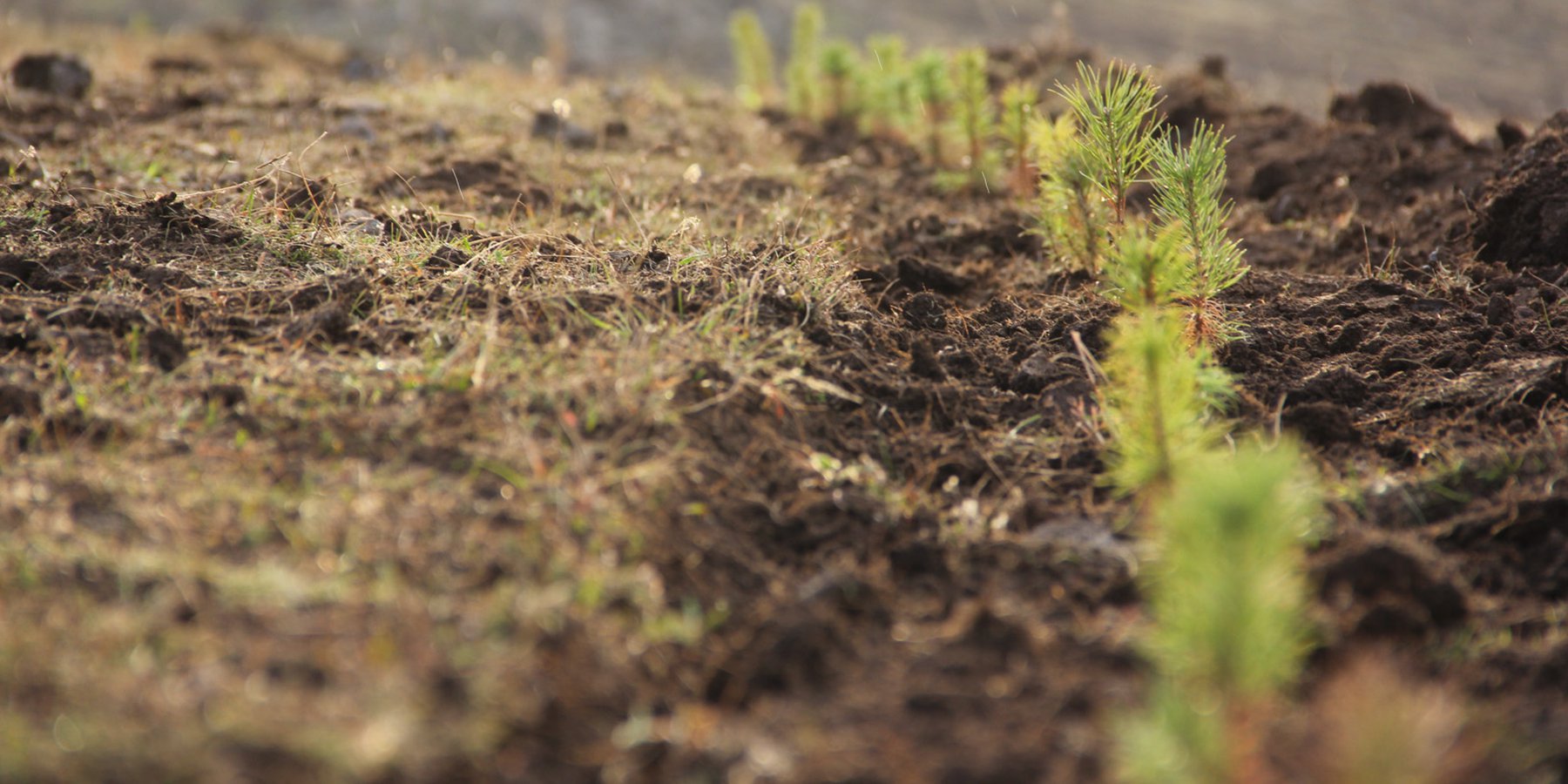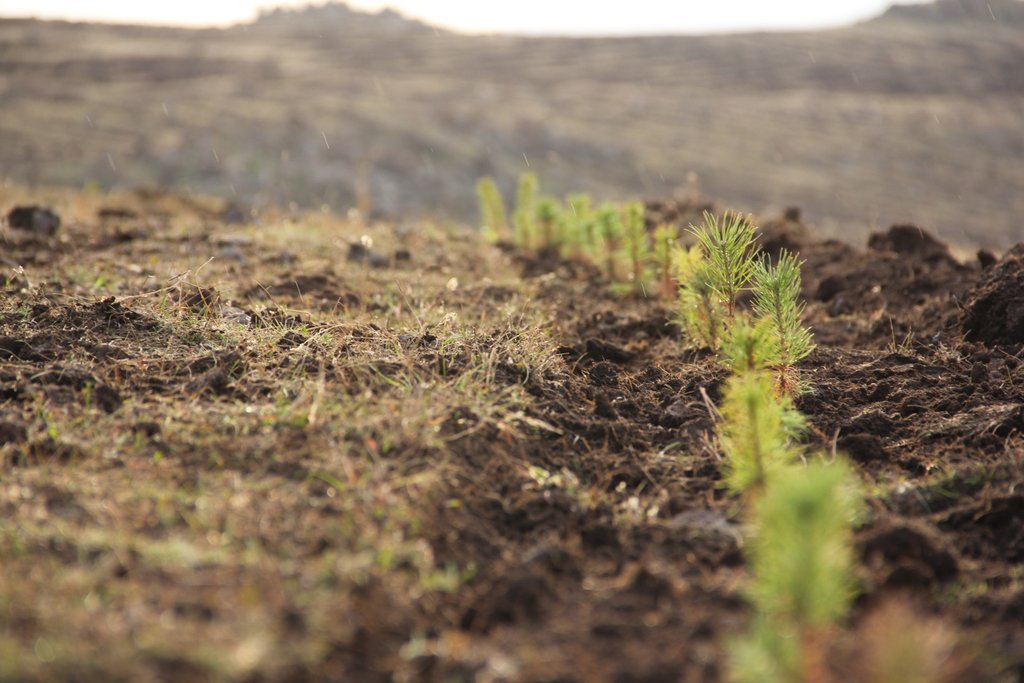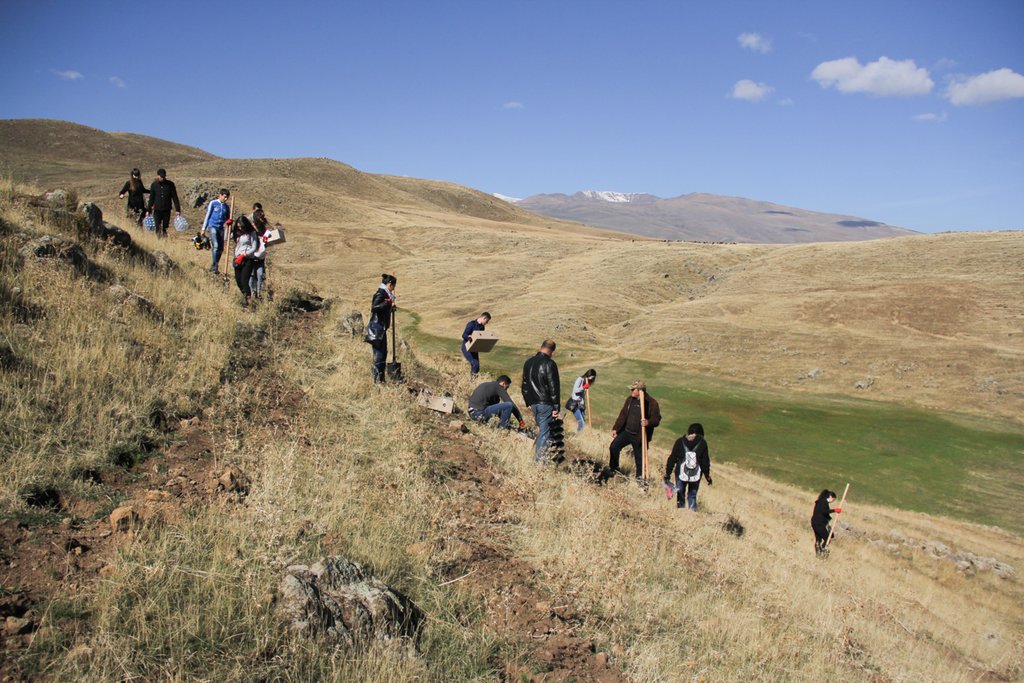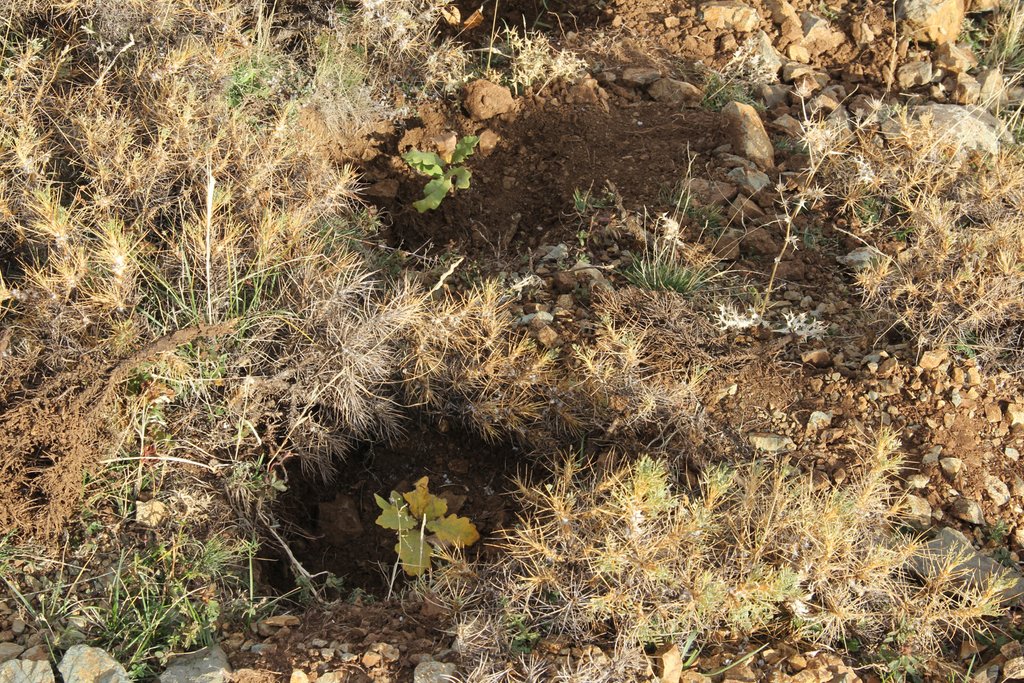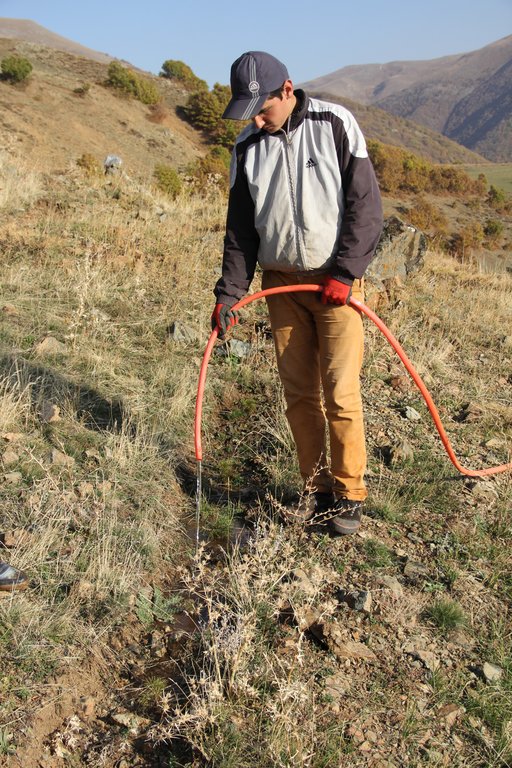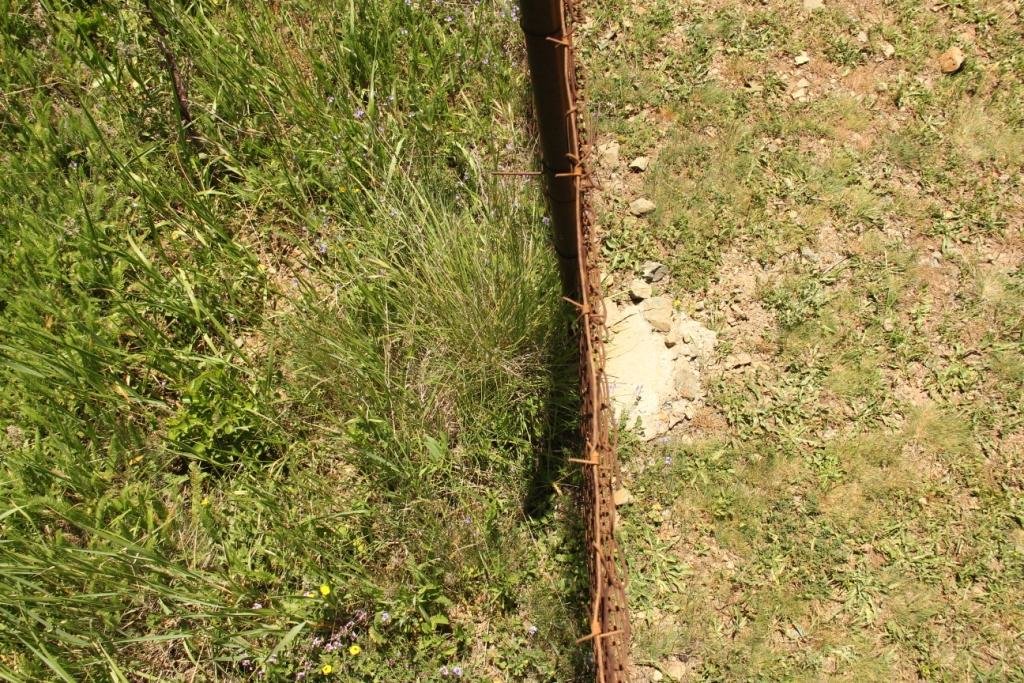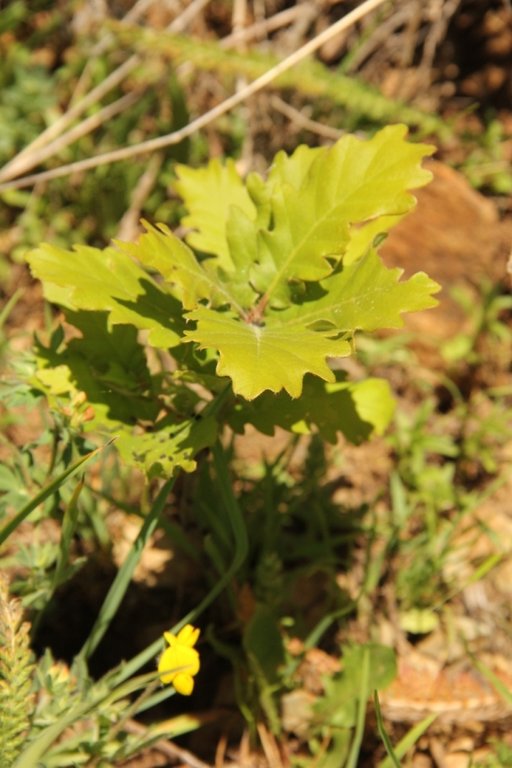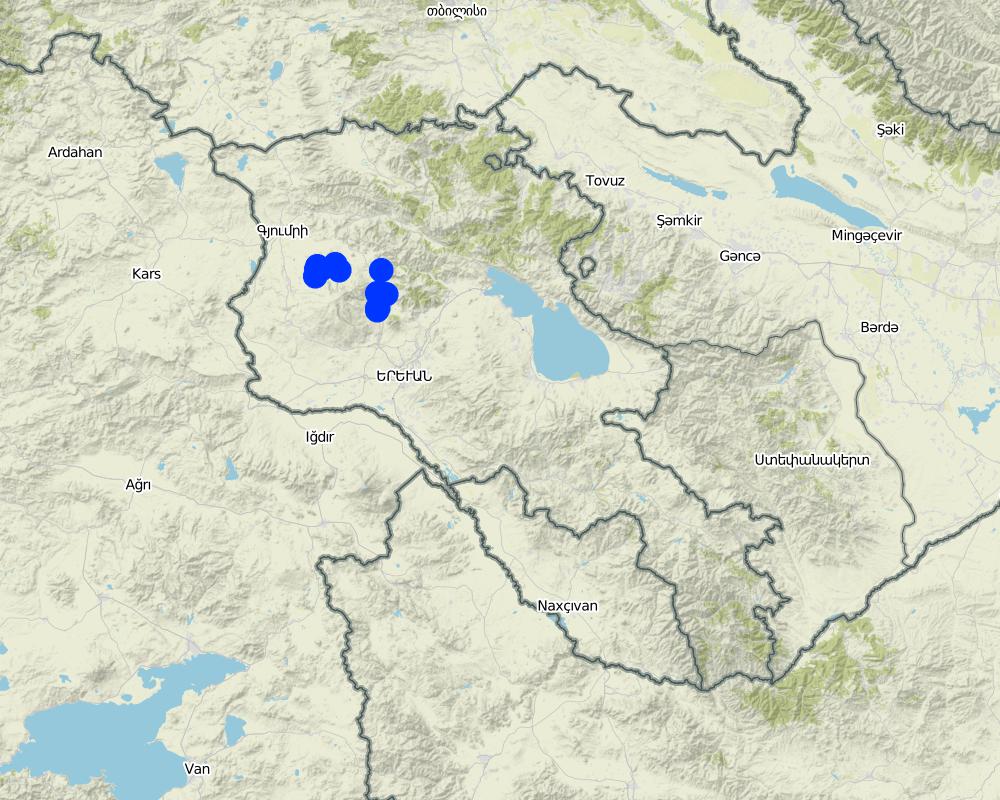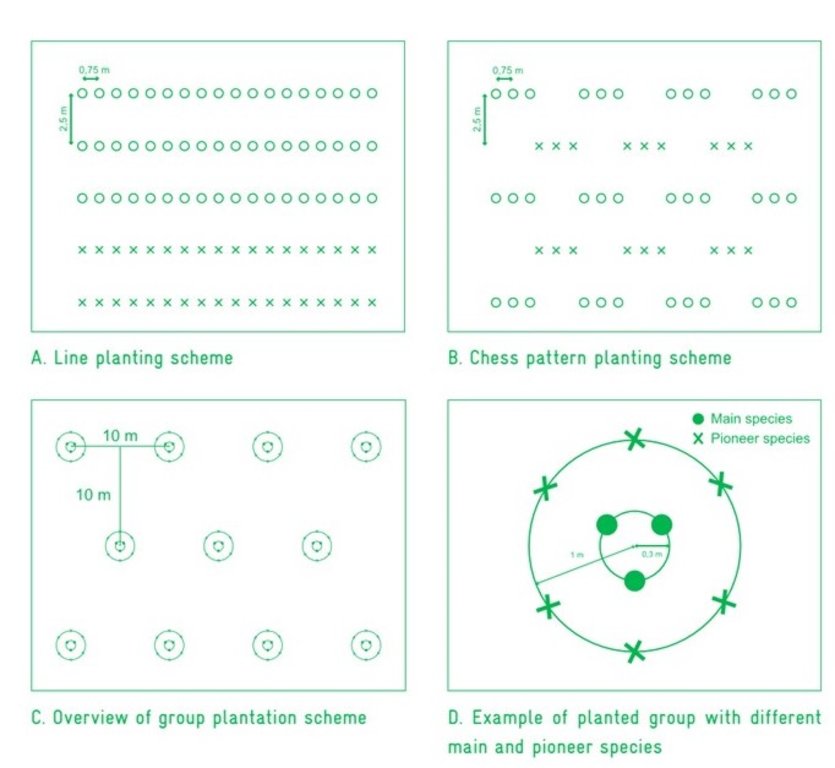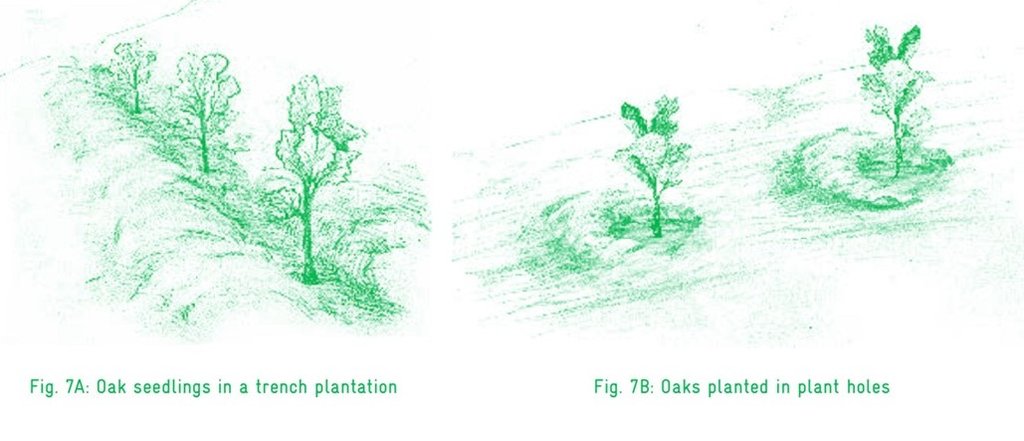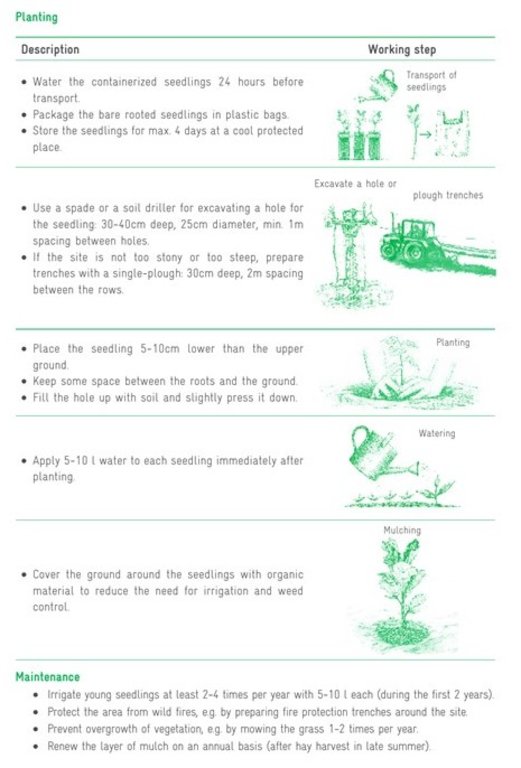High-altitude afforestation for erosion control [Arménie]
- Création :
- Mise à jour :
- Compilateur : Hanns Kirchmeir
- Rédacteur : Artur Hayrapetyan
- Examinateur : Ursula Gaemperli
technologies_4101 - Arménie
Voir les sections
Développer tout Réduire tout1. Informations générales
1.2 Coordonnées des personnes-ressources et des institutions impliquées dans l'évaluation et la documentation de la Technologie
Spécialiste GDT:
Nom du projet qui a facilité la documentation/ l'évaluation de la Technologie (si pertinent)
Integrated Biodiversity Management, South Caucasus (IBiS)Nom du ou des institutions qui ont facilité la documentation/ l'évaluation de la Technologie (si pertinent)
Deutsche Gesellschaft für Internationale Zusammenarbeit (GIZ)1.3 Conditions relatives à l'utilisation par WOCAT des données documentées
Quand les données ont-elles été compilées (sur le terrain)?
04/10/2018
Le compilateur et la(les) personne(s) ressource(s) acceptent les conditions relatives à l'utilisation par WOCAT des données documentées:
Oui
1.4 Déclaration sur la durabilité de la Technologie décrite
Est-ce que la Technologie décrite ici pose problème par rapport à la dégradation des terres, de telle sorte qu'elle ne peut pas être déclarée comme étant une technologie de gestion durable des terres?
Non
1.5 Référence au(x) questionnaire(s) sur les Approches de GDT
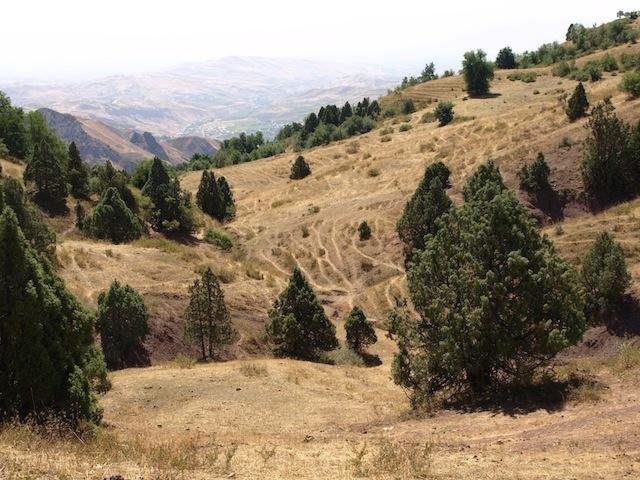
Sustainable managements on pasture and forest lands based … [Tadjikistan]
Sustainable managements on pasture and forest lands based on natural regeneration by electrified fences
- Compilateur : Kakubari Yochitaka

Afforestation/Tree planting [Ouganda]
Tree planting carried out by individual land users on hilly slopes to improve soil cover ,reduce wind strength , provide wood fuel & household income.
- Compilateur : Wilson Bamwerinde
2. Description de la Technologie de GDT
2.1 Courte description de la Technologie
Définition de la Technologie:
Afforestation is a key technologies to protect soil against erosion and provide a wide range of ecosystem services. In this case, afforestation at high altitudes, which is particularly challenging, with the primary purpose of erosion control were planted in small patches with different methods. They form the basis for future community forests in Armenia.
2.2 Description détaillée de la Technologie
Description:
Forests are - in terms of biomass accumulation and stability - the most successful ecosystems in the world. Natural forest ecosystems offer multiple ecosystem services, such as timber and fuel wood provision, water purification, carbon sequestration. In mountainous landscapes, forests have an additional protective function against erosion and natural hazards (e.g., avalanches, landslides, debris flows or rock falls). In the South Caucasus, two natural limits restrict forest expansion: at 2.300-2.600m a.s.l. the upper tree line is visible, whereas steppe and semi-desert ecosystems form the lower tree line.
Socio-economic and geo-physical living conditions:
The intervention area is located at the northern to eastern slopes of Mount Aragats (4013m). The villages are located at 1600 to 1800 m above sea level where the slope meets a plain with stepic soils and crop production while the slopes of the mountains are used for livestock grazing (sheep and cattle).
Purpose of afforestation:
By means of afforestation of degraded pastures, mountainous areas that suffer from erosion and overgrazing should be rehabilitated and erosion protection capacity enhanced. At the same time, the afforestation sites should form the basis for future community forests providing a wide range of ecosystem services, a concept that has not yet been established in Armenia.
Implementation
Between 2014 and 2017 more than 200 hectares were fenced for afforestation, 145 ha were actively afforested in 10 different communities around Mount Aragats in Armenia. The average size of the 20 plots is 10 ha (35 ha being the largest site, 1 ha the smallest one).
The afforestation included different species combinations, planting schemes and methods to determine most cost-efficient afforestation methods for Armenian conditions. All afforestation took place at elevations between 1900 and 2300 m.a.s.l.. The afforestation included fencing of the area to protect the afforestation site against grazing, the preparation of the planting sites according to fixed planting schemes, the actual planting in lines with trenches, single plant holes and group plantings. For some sites, additional irrigation was established for the first years. Particular attention was paid to the species selection which explicitly included fruit trees and shrubs to ensure local economic returns.
Practical experiences
A wide range species was tested. Within the given climate context, pine (Pinus sylvestris), the main non-native species as well as native maple (Acer trautvetteri), Persian Oak (Quercus macranthera) and birch (Betula litwinowii) showed the best results. Particular attention was paid to adapted species to create resilient forest-shrubland with a large number of tree species. In general, planting in trenches shows highest survival rates. Bare root system and containerized seedlings were used for planting. Containerized seedlings definitely provide better survival rate in comparison with bare root system seedlings. Additionally, mulch cover was provided to protect seedlings and keep soil humidity. The main maintenance measures are repeated mulching and weed control and irrigation during the first 3 years. Furthermore, some replanting is continuously taking place as the sites are facing tough environmental conditions (hot summers, drought, short vegetation period).
The plantation was organised and supervised by local NGO's (ATP Armenian Tree Project, ESAC Environmental Sustainability Assistance Center) in close cooperation with the local village population. In a Memorandum of Understandig between the Armenian Ministry of Territorial Administration and Development, the local village administration and GIZ the share of payed labour and own contribution was fixed beforehand.
Impacts and perception
After the first years already first successes are becoming visible contributing to increased vegetation cover, increased biomass and improved soil protection. The communities are proud to be amongst the first in Armenia with a community forest. However, slow growth will require continuous commitment and care on behalf of the community.
2.3 Photos de la Technologie
2.4 Vidéos de la Technologie
Commentaire, brève description:
Short video of ESAC, the implementing NGO, on afforestation background and techniques
https://www.youtube.com/watch?v=cLZ5ucDDclI
Date:
28/10/2018
Lieu:
Aragatsotn and Shirak Marzes
Nom du vidéaste:
ESAC NGO (Khachatur Khachtryan)
Commentaire, brève description:
Short video of ESAC, the implementing NGO on different fencing techniques used for protecting the afforestation sites
https://www.youtube.com/watch?v=INRnvnkYzCE
Date:
28/03/2018
Lieu:
Aragatsotn and Shirak Marzes
Nom du vidéaste:
ESAC NGO (Khachatur Khachtryan)
2.5 Pays/ région/ lieux où la Technologie a été appliquée et qui sont couverts par cette évaluation
Pays:
Arménie
Région/ Etat/ Province:
Shirak and Aragatsotn Marzes
Autres spécifications du lieu:
Lusagyugh, Saralanj, Harich, Arayi, Quchak, Hnaberd, Mets Manatash, Pokr Mantash, Nahapetavan
Commentaires:
Differerent small afforestation plots between 1 and 30 ha with a total of approximately 200 ha
Map
×2.6 Date de mise en œuvre de la Technologie
Si l'année précise est inconnue, indiquez la date approximative: :
- il y a moins de 10 ans (récemment)
2.7 Introduction de la Technologie
Spécifiez comment la Technologie a été introduite: :
- par le biais de projets/ d'interventions extérieures
Commentaires (type de projet, etc.) :
This project introduced community-managed forests for erosion control to different communities. Different planting techniques and species were piloted to identify most appropriate afforestation and management methods.
3. Classification de la Technologie de GDT
3.1 Principal(aux) objectif(s) de la Technologie
- réduire, prévenir, restaurer les terres dégradées
- préserver l'écosystème
- conserver/ améliorer la biodiversité
- atténuer le changement climatique et ses impacts
3.2 Type(s) actuel(s) d'utilisation des terres, là où la Technologie est appliquée

Pâturages
Pâturage extensif:
- Semi-nomadisme/ pastoralisme
Principales espèces animales et principaux produits:
Cattle and sheep

Forêts/ bois
Plantations d'arbres, boisements:
- Variétés mixtes
Produits et services:
- Bois de chauffage
- Fruits et noix
- Pâturage/ broutage
- Protection contre les aléas naturels
Si l'utilisation des terres a changé en raison de la mise en œuvre de la Technologie, indiquez l'utilisation des terres avant la mise en œuvre de la Technologie:
The afforestation sites were previously used as (partly overgrazed) pastures for grazing of mainly cattle. Thus, this technology included a land-use change from grassland/pasture to forest/shrubland.
3.3 Informations complémentaires sur l'utilisation des terres
Approvisionnement en eau des terres sur lesquelles est appliquée la Technologie:
- mixte: pluvial-irrigué
Nombre de période de croissance par an: :
- 1
Densité d'élevage/ chargement (si pertinent):
1-2/ha
3.4 Groupe de GDT auquel appartient la Technologie
- gestion des forêts naturelles et semi-naturelles
- fermeture de zones (arrêt de tout usage, appui à la réhabilitation)
- réduction des risques de catastrophe fondée sur les écosystèmes
3.5 Diffusion de la Technologie
Spécifiez la diffusion de la Technologie:
- répartie uniformément sur une zone
Si la Technologie est uniformément répartie sur une zone, indiquez la superficie couverte approximative:
- < 0,1 km2 (10 ha)
Commentaires:
Individual sites vary between 1 and 35 ha with a total area covered of 200 ha (2 km²) . However, it showed that communities only have the capacity to maintain a maximum size of 10 ha (maintenance). If managed by the community, it should not be larger.
3.6 Mesures de GDT constituant la Technologie

pratiques végétales
- V1: Couverture d’arbres et d’arbustes

modes de gestion
- M1: Changement du type d’utilisation des terres
3.7 Principaux types de dégradation des terres traités par la Technologie

érosion hydrique des sols
- Wt: perte de la couche superficielle des sols (couche arable)/ érosion de surface
- Wg: ravinement/ érosion en ravines

dégradation biologique
- Bc: réduction de la couverture végétale
- Bs: baisse de la qualité et de la composition/ diversité des espèces
3.8 Prévention, réduction de la dégradation ou réhabilitation des terres dégradées
Spécifiez l'objectif de la Technologie au regard de la dégradation des terres:
- prévenir la dégradation des terres
- réduire la dégradation des terres
4. Spécifications techniques, activités, intrants et coûts de mise en œuvre
4.1 Dessin technique de la Technologie
4.2 Spécification/ explications techniques du dessin technique
Needed resources for 1 ha afforestation:
- 2.000-5.000 seedlings
- 10-50 t water (for initial irrigation)
- 40 – 100 working days
- Shuffles or soil driller
- Means of transport
Selection of species
It is recommended to use different local tree species for any afforestation activity, as they can cope best with the given environmental conditions and, therefore, are more resilient towards pests and climatic variations. Most suitable species for afforestation:
-Trautvetters maple (Acer trautvetteri)
-Birch (Betula letwinowii)
-Wild Oriental Apple (Malus orientalis)
-Scott’s Pine (Pinus sylvestris var. hamata)
-Persian Oak (Quercus macranthera)
-Raspberry (Rubus idaeus)
-Mountain ash (Sorbus aucuparia)
For selecting suitable species, screening of the wider project area is essential in order to prepare a list of species, which would naturally grow under the given ecological conditions
Planting scheme
The technical drawings describe different potential planting schemes. A further figure describes the advantages and disadvantages of each scheme.
Planting season
The climate in the South Caucasus region shows low precipitation rates in the summer period. As seedlings have a small root system, young trees are more sensitive to drought. The best time for planting is either autumn or early spring as during autumn, winter and spring, more moisture is available that helps the seedlings to develop deeper root systems to survive during summer droughts.
Fencing
In many cases, afforestation sites are located on pasture land. To protect the planted seedlings from browsing by livestock or wild game, it is recommended to fence the afforestation site before starting the plantation of the seedlings.
Planting
The planting process is specified in one of the technical drawings. With a hole driller planting of one tree takes 2-4 minutes, planting by hand 8-10 min. Each seedling is waterered with an intial 5-10 l of water.
4.3 Informations générales sur le calcul des intrants et des coûts
Spécifiez la manière dont les coûts et les intrants ont été calculés:
- par superficie de la Technologie
Indiquez la taille et l'unité de surface:
1 ha
Indiquez la monnaie utilisée pour le calcul des coûts:
- dollars US
4.4 Activités de mise en place/ d'établissement
| Activité | Type de mesures | Calendrier | |
|---|---|---|---|
| 1. | Selection of afforestation site, plantation scheme and species | Modes de gestion | anytime |
| 2. | Fencing of the area (if area is being grazed or wild game is browsing seedlings | Structurel | before planting |
| 3. | Prepare and transfer seedlings to the site | Modes de gestion | before planting |
| 4. | Excavate whole for the seedling (30-40cm deep, 25 cm diameter, 1m spacing between wholes) | Structurel | autumn, early spring |
| 5. | Place the seedling and fill hole with soil | Végétale | autumn, early spring |
| 6. | Apply 5-10 l of water immediately after planting | Modes de gestion | after planting |
| 7. | Cover soil around seedling with mulch and organic material | Végétale | after planting |
4.5 Coûts et intrants nécessaires à la mise en place
| Spécifiez les intrants | Unité | Quantité | Coûts par unité | Coût total par intrant | % des coût supporté par les exploitants des terres | |
|---|---|---|---|---|---|---|
| Main d'œuvre | Local workers for plantation of trees | seedlings | 2500,0 | 0,27 | 675,0 | 10,0 |
| Main d'œuvre | Installation of fence and posts | person day | 191,0 | 12,3 | 2349,3 | |
| Equipements | Equipment (hummer, driller, etc.) | set | 1,0 | 141,8 | 141,8 | 30,0 |
| Matériel végétal | Tree seedlings | pieces | 2500,0 | 0,31 | 775,0 | |
| Matériel végétal | Mulching | kg | 1250,0 | 0,03 | 37,5 | |
| Matériaux de construction | Fencing (permanent mesh wire fence) | meter | 317,0 | 1,35 | 427,95 | 10,0 |
| Matériaux de construction | Irrigation system | set | 1,0 | 889,0 | 889,0 | 15,0 |
| Matériaux de construction | Metal posts for fence (1.8m) | pieces | 106,0 | 2,97 | 314,82 | |
| Matériaux de construction | sand | kg | 3444,0 | 0,012 | 41,33 | |
| Matériaux de construction | Other material(electrode, wire armature, metal disc) | set | 1,0 | 386,9 | 386,9 | 20,0 |
| Matériaux de construction | Cement | kg | 1148,0 | 0,12 | 137,76 | |
| Autre | Transporation of mulch | time | 1,0 | 102,8 | 102,8 | |
| Autre | Transporation of construction materials | time | 5,0 | 92,5 | 462,5 | |
| Autre | Transporation of workers to the field | time | 15,0 | 30,2 | 453,0 | |
| Autre | Transporation of seedlings | time | 1,0 | 51,4 | 51,4 | |
| Coût total de mise en place de la Technologie | 7246,06 | |||||
Si le coût n'est pas pris en charge à 100% par l'exploitant des terres, indiquez qui a financé le coût restant:
GIZ Project
Commentaires:
The above calculation is not made on purely 1 ha, since the project did not implement afforestation on 1 ha. This calculation was done on 2.6 ha, then the costs are proportionally distributed for 1 ha.
4.6 Activités d'entretien/ récurrentes
| Activité | Type de mesures | Calendrier/ fréquence | |
|---|---|---|---|
| 1. | Irrigation of young seedlings with 5-10 l | Modes de gestion | 2-4 times per year for the first two years |
| 2. | Preparation of fire protection trenches | Structurel | if needed |
| 3. | Mowing to prevent overgrowth of seedlings | Végétale | 1-2 times per year |
| 4. | Renew mulch layer | Modes de gestion | annually after hay harvest in summer |
| 5. | Replanting of seedlings (10% each year) | Modes de gestion | annually to be done for the first 5 years |
4.7 Coûts et intrants nécessaires aux activités d'entretien/ récurrentes (par an)
| Spécifiez les intrants | Unité | Quantité | Coûts par unité | Coût total par intrant | % des coût supporté par les exploitants des terres | |
|---|---|---|---|---|---|---|
| Main d'œuvre | Irrigation of young seedlings with 5-10 l | Man/day | 1,0 | 10,0 | 10,0 | 100,0 |
| Main d'œuvre | Preparation of fire protection trenches | rm | 150,0 | 0,34 | 51,0 | 100,0 |
| Main d'œuvre | Mowing to prevent overgrowth of seedlings | Man/day | 4,0 | 10,0 | 40,0 | 50,0 |
| Main d'œuvre | Renew mulch layer (including mulch value) | Man/day | 5,0 | 10,0 | 50,0 | 50,0 |
| Matériel végétal | Seedlings for replantation (including labour) | seedlings | 1200,0 | 0,51 | 612,0 | 50,0 |
| Autre | Petrol for irrigation | liter | 7,0 | 0,8 | 5,6 | |
| Coût total d'entretien de la Technologie | 768,6 | |||||
Si le coût n'est pas pris en charge à 100% par l'exploitant des terres, indiquez qui a financé le coût restant:
GIZ project
Commentaires:
The rather high costs are mostly linked to the permanent fence to protect seedlings against grazing and to high number of seedlings per hectare. In some parts initial irrigation was necessary due to dry summer conditions. Maintenance activities such as irrigation of seedlings in summer, anti-fire measures, replantation of seedlings (10 % each year for 5 years), mowing of grass and renewing of mulch layer are needed.
4.8 Facteurs les plus importants affectant les coûts
Décrivez les facteurs les plus importants affectant les coûts :
With costs of approximately 5,700 USD/ha including fencing (30%), planting (30%) and seedlings (40%) afforestation is very intensive in financial resources. It is very likely that these high costs will limit the upscaling of the afforestation process. There are some options to reduce costs:
•Fence large areas and try to have sites in square or circle shape
•Increase number of seedlings planted by person by using soil-drillers
•Use cheaper fencing material (e.g. game protection fence, poles without concrete)
•Reduce seedling number to 2000-3000 seedlings/ha
•Using seeds (e.g. oak) instead of seedlings
•Regrow seeds in local low-cost nurseries (e.g. Lusagyugh)
5. Environnement naturel et humain
5.1 Climat
Précipitations annuelles
- < 250 mm
- 251-500 mm
- 501-750 mm
- 751-1000 mm
- 1001-1500 mm
- 1501-2000 mm
- 2001-3000 mm
- 3001-4000 mm
- > 4000 mm
Spécifiez la pluviométrie moyenne annuelle (si connue), en mm:
521,00
Spécifications/ commentaires sur les précipitations:
Precipitation peak between May and June.
Indiquez le nom de la station météorologique de référence considérée:
Aparan, Aragatsotn Marz, Armenia
Zone agro-climatique
- semi-aride
According to Köppen and Geiger, the climate is classified as Dfb (Cold/continental, no dry season, warm summers). Annual mean temperature is 5.2. °C. The warmest month of the year is August, with an average temperature of 16.4 °C. January has the lowest average temperature of the year with -6.9 °C.
based on data from the following source: https://www.arcgis.com/home/webmap/viewer.html?layers=3ac478a468c245ef9bfd5533f7edbf93
5.2 Topographie
Pentes moyennes:
- plat (0-2 %)
- faible (3-5%)
- modéré (6-10%)
- onduleux (11-15%)
- vallonné (16-30%)
- raide (31-60%)
- très raide (>60%)
Reliefs:
- plateaux/ plaines
- crêtes
- flancs/ pentes de montagne
- flancs/ pentes de colline
- piémonts/ glacis (bas de pente)
- fonds de vallée/bas-fonds
Zones altitudinales:
- 0-100 m
- 101-500 m
- 501-1000 m
- 1001-1500 m
- 1501-2000 m
- 2001-2500 m
- 2501-3000 m
- 3001-4000 m
- > 4000 m
Indiquez si la Technologie est spécifiquement appliquée dans des:
- non pertinent
5.3 Sols
Profondeur moyenne du sol:
- très superficiel (0-20 cm)
- superficiel (21-50 cm)
- modérément profond (51-80 cm)
- profond (81-120 cm)
- très profond (>120 cm)
Texture du sol (de la couche arable):
- moyen (limoneux)
Texture du sol (> 20 cm sous la surface):
- moyen (limoneux)
Matière organique de la couche arable:
- moyen (1-3%)
5.4 Disponibilité et qualité de l'eau
Profondeur estimée de l’eau dans le sol:
5-50 m
Disponibilité de l’eau de surface:
moyenne
Qualité de l’eau (non traitée):
faiblement potable (traitement nécessaire)
La salinité de l'eau est-elle un problème? :
Non
La zone est-elle inondée?
Non
5.5 Biodiversité
Diversité des espèces:
- moyenne
Diversité des habitats:
- faible
5.6 Caractéristiques des exploitants des terres appliquant la Technologie
Sédentaire ou nomade:
- Sédentaire
Orientation du système de production:
- mixte (de subsistance/ commercial)
Revenus hors exploitation:
- 10-50% de tous les revenus
Niveau relatif de richesse:
- pauvre
- moyen
Individus ou groupes:
- groupe/ communauté
- coopérative
Niveau de mécanisation:
- travail manuel
- mécanisé/ motorisé
Genre:
- femmes
- hommes
Age des exploitants des terres:
- personnes d'âge moyen
- personnes âgées
5.7 Superficie moyenne des terres détenues ou louées par les exploitants appliquant la Technologie
- < 0,5 ha
- 0,5-1 ha
- 1-2 ha
- 2-5 ha
- 5-15 ha
- 15-50 ha
- 50-100 ha
- 100-500 ha
- 500-1 000 ha
- 1 000-10 000 ha
- > 10 000 ha
Cette superficie est-elle considérée comme de petite, moyenne ou grande dimension (en se référant au contexte local)?
- petite dimension
5.8 Propriété foncière, droits d’utilisation des terres et de l'eau
Propriété foncière:
- communauté/ village
Droits d’utilisation des terres:
- communautaire (organisé)
Droits d’utilisation de l’eau:
- communautaire (organisé)
5.9 Accès aux services et aux infrastructures
santé:
- pauvre
- modéré
- bonne
éducation:
- pauvre
- modéré
- bonne
assistance technique:
- pauvre
- modéré
- bonne
emploi (par ex. hors exploitation):
- pauvre
- modéré
- bonne
marchés:
- pauvre
- modéré
- bonne
énergie:
- pauvre
- modéré
- bonne
routes et transports:
- pauvre
- modéré
- bonne
eau potable et assainissement:
- pauvre
- modéré
- bonne
services financiers:
- pauvre
- modéré
- bonne
6. Impacts et conclusions
6.1 Impacts sur site que la Technologie a montrés
Impacts socio-économiques
Production
production fourragère
Commentaires/ spécifiez:
Within the fenced afforestation site, the grass could be cut and used as hay. The protection from grazing helps biomass development which leads to better protection from Surface water Erosion and this lead to soil-regeneration and increase of productivity.
qualité des forêts/ bois
Commentaires/ spécifiez:
The natural forest was removed for the purpose of grazing and the forest cover will be now re-established on the afforestation sites.
production forestière non ligneuse
Commentaires/ spécifiez:
We mixed shrub species like raspberries and fruit-trees (wilde plumb) between the main tree species to create short time Benefit for the village people.
diversité des produits
Commentaires/ spécifiez:
In addition to the wide spread grazing land use now the hay production in the fenced afforestation site is increased for the first 1-2 decades (until the canopy is too dense) and the collection of berries and fruits give additional income opportunities. In the Long terme fuel wood production can be expected from the forested land.
surface de production
Commentaires/ spécifiez:
The grazing range is limited by the fenced afforestation site. This is relevant in the first couple of years before hay or fruit/berry productivity is able to fully compensate the loss of grazing range.
Revenus et coûts
charge de travail
Commentaires/ spécifiez:
The maintenance of the afforestation site lead to increase of workload especially in the first 2-4 years when hay cutting and Irrigation is needed until the tree seedlings are well established.
Impacts socioculturels
possibilités de loisirs
Commentaires/ spécifiez:
As there is almost no forest near to the villages every woodland is very attractive for recreational purpose, but it will Need 2-3 decades until this function will be fulfilled by the afforestation site.
connaissances sur la GDT/ dégradation des terres
Commentaires/ spécifiez:
The local stakeholders got hands on training on fencing, afforestation and maintenance of afforestation sites.
Impacts écologiques
Cycle de l'eau/ ruissellement
ruissellement de surface
Commentaires/ spécifiez:
The fencing of the afforestation site immediately stops the heavy grazing Impact which leads to fast recovery of the Vegetation. The improved Vegetation cover and better development of the root System reduce Surface water run of Speed and increase water Infiltration.
évaporation
Commentaires/ spécifiez:
An increase of vegetation and the leaf area index will lead to an increase of evaporation.
Sols
perte en sol
Commentaires/ spécifiez:
Increase of vegetation cover and reduction of water runoff will lead to decrease of soil loss.
matière organique du sol/ au dessous du sol C
Commentaires/ spécifiez:
The increase of vegetation leads to an increase of root development. Additionally, the increase of vegetation produces more litter, as no grazing is applied. The increase in litter leads to an increase of an humus layer and therefore to more below ground carbon.
Biodiversité: végétale, animale
Couverture végétale
Commentaires/ spécifiez:
Especially the fencing leads to fast increase of vegetation cover.
biomasse/ au dessus du sol C
Commentaires/ spécifiez:
The local stakeholders got hands on training on fencing, afforestation and maintenance of afforestation sites.
diversité végétale
Commentaires/ spécifiez:
The stop of grazing and the new micro-habitats created by the shadow of the tree seedlings have let to an increase in plant diversity. This process might be reverse when the tree canopy is closed and less light is available for the herb-layer, but this will take several decades.
diversité des habitats
Commentaires/ spécifiez:
The plain grasslands habitats are diversified by patches of forest.
6.2 Impacts hors site que la Technologie a montrés
capacité tampon/de filtration
Commentaires/ spécifiez:
The decrease of water run off increase the water capacity of the habitat and the afforested area will provide increase buffer capacity in the case of intensive rainfalls.
sédiments (indésirables) transportés par le vent
Commentaires/ spécifiez:
The high grass and trees reduce wind speed at ground level.
Commentaires concernant l'évaluation des impacts:
Most of the afforestation sites are locate uphill of villages. Village people are expecting protection from cold down-hill winds from the mountain and an increase of air-moisture by the evapo-transpiration of the forest.
6.3 Exposition et sensibilité de la Technologie aux changements progressifs et aux évènements extrêmes/catastrophes liés au climat (telles que perçues par les exploitants des terres)
Extrêmes climatiques (catastrophes)
Catastrophes météorologiques
| Comment la Technologie fait-elle face à cela? | |
|---|---|
| orage local | modérément |
| averse de grêle locale | modérément |
| tempête de neige locale | bien |
Catastrophes biologiques
| Comment la Technologie fait-elle face à cela? | |
|---|---|
| infestation par des insectes/ vers | modérément |
Autres conséquences liées au climat
Autres conséquences liées au climat
| Comment la Technologie fait-elle face à cela? | |
|---|---|
| prolongement de la période de croissance | bien |
6.4 Analyse coûts-bénéfices
Quels sont les bénéfices comparativement aux coûts de mise en place (du point de vue des exploitants des terres)?
Rentabilité à court terme:
négative
Rentabilité à long terme:
légèrement positive
Quels sont les bénéfices comparativement aux coûts d'entretien récurrents (du point de vue des exploitants des terres)?
Rentabilité à court terme:
légèrement négative
Rentabilité à long terme:
positive
Commentaires:
In the first decade the efforts on maintenance are high and it can be expected that the return of natural resources (hay, berries, fruits) is significantly lower the the maintenance efforts. As soon the trees are established and larger than 1.3 the root system is well establish and the trees are resistant to droughts, no vegetation cutting is needed and even game or cattle browsing will not necessarily lead to lethal damage.
6.5 Adoption de la Technologie
- cas isolés/ expérimentaux
Parmi tous ceux qui ont adopté la Technologie, combien d'entre eux l'ont fait spontanément, à savoir sans recevoir aucune incitation matérielle ou aucun paiement?
- 0-10%
6.6 Adaptation
La Technologie a-t-elle été récemment modifiée pour s'adapter à l'évolution des conditions?
Oui
Si oui, indiquez à quel changement la Technologie s'est adaptée:
- changements/ extrêmes climatiques
Spécifiez l'adaptation de la Technologie (conception, matériaux/ espèces, etc.):
drought-adapted species, adaptation of planting schemes
6.7 Points forts/ avantages/ possibilités de la Technologie
| Points forts/ avantages/ possibilités du point de vue de l'exploitant des terres |
|---|
| Extension of forest cover of communities, new habitat for wild creators, forest will be a fire wood and non timber products source for local inhabitants, attraction of tourists into the communities, increased water regulating function, improved soil quality, increased vegetation, microclimate formation function, wind velocity reduction, reduced land degradation, nice view of the area due to afforestation,increased fodder for cattle |
| empowerment of the local capacities on sustainable land management |
| successful demonstration of erosion control measures |
| Points forts/ avantages/ possibilités du point de vue du compilateur ou d'une autre personne ressource clé |
|---|
| Diversification of land use options for local stakeholders. Future options for sustainable firewood supply, non-timber forests products (berries) and recreation |
| Option to use grass from cutting in between as fodder/hay production |
| side-effect of fencing is increase in biodiversity of grassland species due to exclusion from grazing. |
6.8 Faiblesses/ inconvénients/ risques de la Technologie et moyens de les surmonter
| Faiblesses/ inconvénients/ risques du point de vue de l’exploitant des terres | Comment peuvent-ils être surmontés? |
|---|---|
| Reduces pasture land of community, which was converted into a forest | Villagers/farmers need to increase the amount of hay from their homestead gardens using irrigation |
| Faiblesses/ inconvénients/ risques du point de vue du compilateur ou d'une autre personne ressource clé | Comment peuvent-ils être surmontés? |
|---|---|
| strong need for care taking in the first years | community commitment, strong ownership |
| Expensive due to high costs for fencing | Consider alternative, cheaper fencing methods (e.g. wildlife protection fence) |
| Complicated decision making processes by the project | More mandate given to the implementing NGOs |
7. Références et liens
7.1 Méthodes/ sources d'information
- visites de terrain, enquêtes sur le terrain
- interviews/entretiens avec les exploitants des terres
- interviews/ entretiens avec les spécialistes/ experts de GDT
2 international (Huber, Kirchmeir)
national?
- compilation à partir de rapports et d'autres documents existants
Information extracted from different project reports and submitted financial statements from implementation
7.2 Références des publications disponibles
Titre, auteur, année, ISBN:
Handbook on Integrated Erosion Control A Practical Guide for Planning and Implementing Integrated Erosion Control Measures in Armenia, GIZ (ed.), 2018, ISBN 978-9939-1-0721-9
Disponible à partir d'où? Coût?
GIZ Armenia
7.3 Liens vers les informations pertinentes disponibles en ligne
Titre/ description:
Project website of the GIZ program
URL:
http://biodivers-southcaucasus.org/
Liens et modules
Développer tout Réduire toutLiens

Sustainable managements on pasture and forest lands based … [Tadjikistan]
Sustainable managements on pasture and forest lands based on natural regeneration by electrified fences
- Compilateur : Kakubari Yochitaka

Afforestation/Tree planting [Ouganda]
Tree planting carried out by individual land users on hilly slopes to improve soil cover ,reduce wind strength , provide wood fuel & household income.
- Compilateur : Wilson Bamwerinde
Modules
Aucun module trouvé


